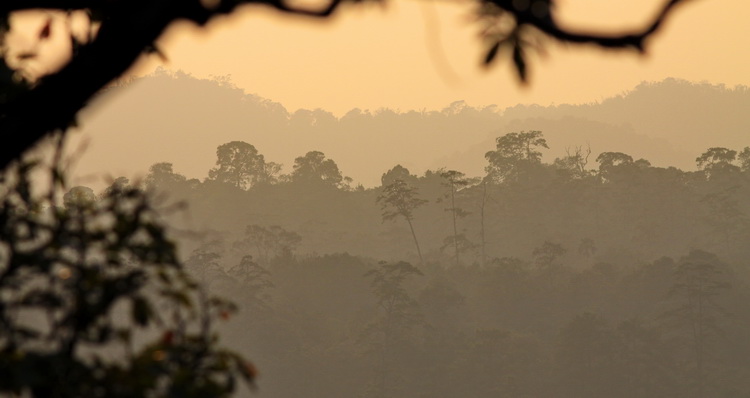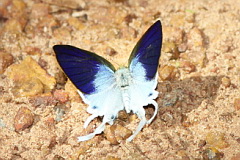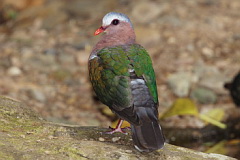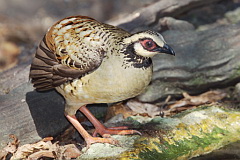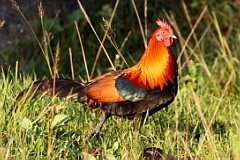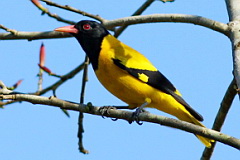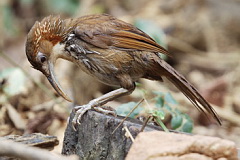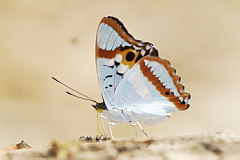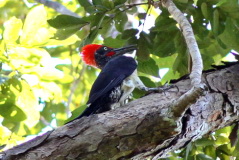Overview
At nearly 1,000 square kilometres, Nam Nao has been a national park since 1972. The area is scenic, mountainous and consists of a number of different forest types including dipterocarp, deciduous, evergreen, hill evergreen and pine. It's this range of accessible habitats that makes Nam Nao a great birding spot. Elephant are quite common in the forest and there's a fair chance of running into one whilst birding. Information on this page verified/accurate as of 3 Mar 2022.
View across hills to east of trails viewpoint
The trail network is one of the best maintained of any national park of Thailand. A few days here should produce an impressive bird list. Despite these attractions, Nam Nao is one of the less-visited birding areas of Thailand - mainly on account of its outposted location, away from the mountains of the northwest. For those with time and an interest in under watched sites, Nam Nao could be combined with Phu Hin Rong Kla, Thung Salaeng and/or Phu Suan Sai National Parks.
Access
The park entrance is found along Highway 12, directly opposite the Km 406 marker, about 50 kilometres east of Lom Sak, which is itself about 50 kilometres north of the provincial capital, Petchabun. Driving time from either Bangkok or Chiang Mai is between five and six hours. From Bangkok head to Saraburi and then north on Highway 21 to Lom Sak. Just before Lom Sak turn east onto Highway 12. From Chiang Mai take Highway 11 to Phitsanulok and then Highway 12 directly to Lom Sak and Nam Nao. At the park entrance, pay the usual fee and proceed 1.7 kilometres to the parking area, where the facilities are located; restaurants, visitor centre, campsite and accommodation office.
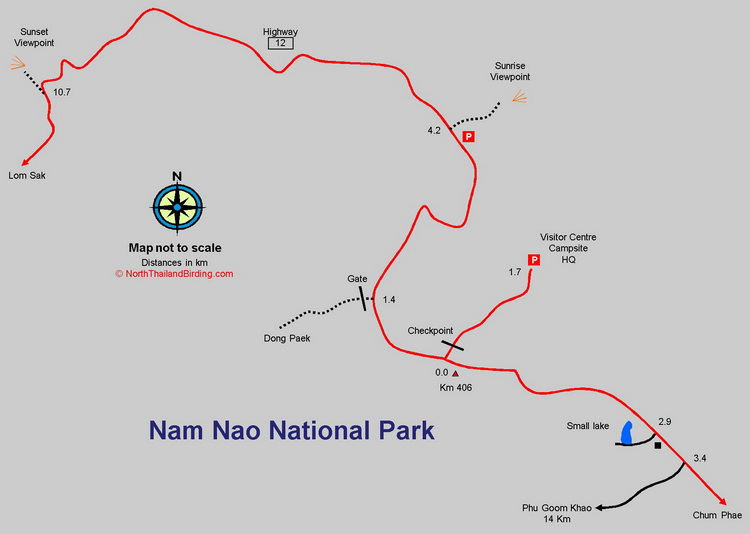
Accommodation and Facilities
Nam Nao has a good range of park accommodation; from camping to a large number of bungalows. This is just as well, since accommodation immediately outside the park is non-existent. In the dry season advanced booking of park bungalows is essential, as Nam Nao is very popular. At other times enquire at the visitor centre, where it should be possible to obtain a bungalow. The campsite is huge, and tents can be rented as well as mats, sleeping bags, pillows etc. If camping, come prepared for cold nights - ground frost is common here in the cool season. Those camping will also be awoken an hour before sunrise by the daily van that drives around loudly broadcasting trips to see the morning fog and sunrise from the Sunrise Viewpoint.
Other than park accommodation the town of Lom Sak has a good selection of hotels and resorts, but is a 40-50 minute drive away, so not that convenient. A few simple resorts, most signed in Thai, can be found about 20 kilometres west of the park, back toward Lom Sak, though food at these would need to be requested in advanced. Fortunately a few simple restaurants are found around the visitor centre in the park and are open early to late, so are great places to eat. Note that it's a regulation that only beer, not hard liqour, is sold or allowed in the park.
Birding
Nam Nao is one of the better localities for finding a number of species that can be difficult elsewhere. These include Bar-backed Partridge, Silver Pheasant, Collared Falconet, Red-headed Trogon, Greater Yellownape, Greater Flameback, Large Scimitar Babbler, Red-billed Scimitar Babbler, White-headed Babbler and Brown Prinia. A number of areas are worth birding.
Campsite and HQ Areas The open areas with scattered trees and bushes around the headquarters, campsite and accommodation units are extensive and make worthwhile birding. The main road from the entrance to the visitor centre has several roads branching off and several trails run around the campsite between various areas. The car parking area makes a good early morning viewpoint for scanning the surrounding tall trees which can have Mountain Imperial Pigeon, Vernal Hanging Parrot and Great Barbet. The visitor centre has a veranda which is a pleasant place to eat and drink and backs immediately onto the forest. Passing time here can reveal some good species including Red-headed Trogon and passing feeding flocks. The scattered trees around the campsites can be good for a variety of woodpeckers including both Greater Flameback and Greater Yellownape. Small Minivet can sometimes be found around the open areas of the campsite, and a couple of groups of White-crested Laughingthrush will often allow close approach as they have become accustomed to the crowds. |
|
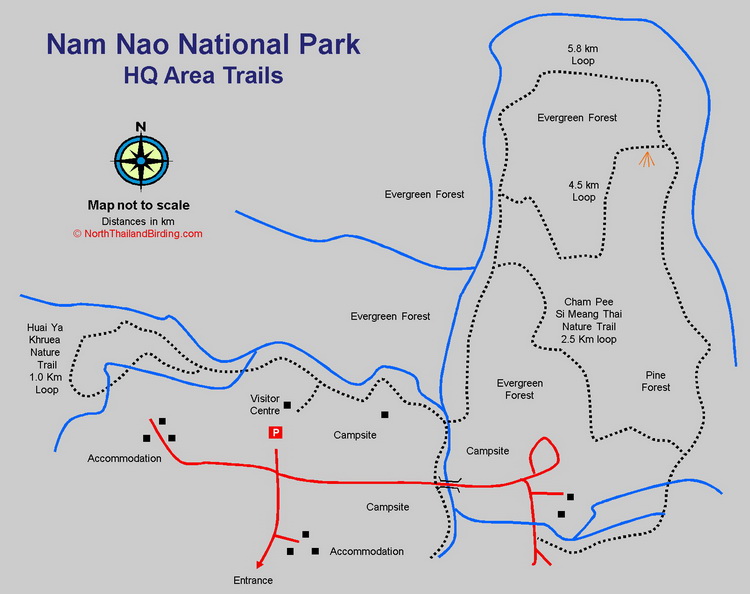
|
Huai Ya Khruea Nature Trail This trail starts to the right of the visitor centre and just left of the toilet block and is the most popular trail in the park on account of its close proximity to the visitor centre and concreted walkway. Despite this, it holds some good birds for those out early. Bar-backed Partridge can be heard early morning and a slow walk will often reveal a few on the forest floor. As the trail passes through extensive bamboo growth there's a good chance of Collared Babbler and Red-billed Scimitar Babbler, and sometimes the much rarer Bamboo Woodpecker. The dark gullies of the smaller rivulets do hold Dark-sided Thrush and Orange-headed Thrush but finding them is difficult. Longer Loop Trails A series of loop trails can be found to the east of the small river bisecting the campsite. All three of these longer trails start at the same river crossing, a hundred metres or so in from the road bridge crossing the river in the campsite. The well-marked starting point can also be found walking east from the Huai Ya Khruea Nature Trail along the river for a couple of hundred metres. All three trails follow the river through evergreen forest before branching off at different distances, climbing up into drier pine forest and returning to the campsite. The shorter loop, also called the Chem Pee Si Thai Nature Trail, is 2.5 or 3 kilometres, depending on which sign you believe. The medium length trail is 4.5 kilometres and passes over a good viewpoint. The longest of the trails is 5.8 kilometres Species and habitat along each are similar. Silver Pheasant is most regularly seen along the river section of these trails. A while host of other good species are possible including Orange-breasted Trogon, Red-headed Trogon, Silver-breasted Broadbill, Blue Pitta, Common Green Magpie, Puff-throated Bulbul, Alstrom's Warbler, Siberian Blue Robin, Purple-naped Spiderhunter and Northern White-crowned Forktail. The open pine forest is often good for Collared Falconet, Eurasian Jay and Blossom-headed Parakeet. Phu Goom Khao Track Phu Goom Khao is a small hill reached by a 14 kilometre track starting 3.4 kilometres east of the park entrance. In the dry season the track is easily passable by two-wheel drive vehicle, but can be incredibly dusty. The first two or three kilometres pass through damper forest, more akin to evergreen, after which the habitat becomes mixed with pine forest gradually giving way to more open grassland with interspersed pines. At Phu Goom Khao is a small parking area and a barrier across the track. From here a short trail goes left, up the hill to a low viewpoint. Stopping and investigating any area along this track should produce a good selection of birds. Some highlights could include Chinese Francolin, Collared Falconet, Oriental Turtle Dove, White-bellied Woodpecker, Burmese Nuthatch, Red-billed Blue Magpie, Black-hooded Oriole and Brown Prinia. Dong Paek Track This track start starts 1.4 Km west of the park entrance and has habitat and species similar to the Phu Goom Khao Track. A gate bars entry to vehicles so this track is only readily walked. However the sign on the gate, in Thai, reads "No entry after dark – contact park HQ for access key". Sunrise and Sunset Viewpoints More tourist attractions than birding sites. However, both offer views across the surrounding forest canopy and can be worth visiting. Previously a trail started at the Sunrise Viewpoint, leading 3.5 kilometres back to the park visitor centre, but has become disused and diffiuclt to follow. |
Checklist
Checklist of species.
Gallery
Additional images from Nam Nao available in the Thailand Travel gallery.
Sunrise and Sunset
Detailed sunrise and sunset times.

